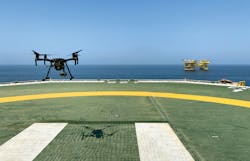Drones set to transform oil and gas operations
Motaz Mashouk * Saudi Aramco
Commercial drones, or unmanned aerial vehicles (UAVs), have undergone a technological revolution in the past five years. The development of high-quality sensors, intelligent motors, and low-cost navigation systems have expanded their use and affordability. Their potential continues to evolve, with companies investing $3.8 billion in drone research and development in 2022.
At Aramco, UAVs have transformed many of the key tasks we perform at our facilities and across our infrastructure, and we are implementing a strategy over the next few years to increase their role across our operations — including technology investment to localize and scale-up deployment.
A new tool for the oil and gas sector
Our industry is one of the fastest-growing sectors for drone use. Aramco uses UAVs to inspect and maintain a whole range of facilities, from onshore and offshore sites to power system infrastructure; as well as perform aerial mapping, emergency response and environmental monitoring.
UAVs are currently manufactured with three configurations — fixed wing, multi-rotor, or a combination of the two, known as vertical takeoff and landing (VTOL) fixed-wing UAVs. Multi-rotor UAVs can take-off and land vertically, as well as hover with ultimate maneuverability, making them ideal for site-based, short-range applications. Fixed-wing vehicles carry out tasks that require travelling longer distances, such as pipeline inspections, land surveys, and offshore exploration and operations, and the VTOL fixed-wing UAVs eliminate the need for runways during takeoffs and landings.
Drones are making a significant difference because they can get to remote and hazardous locations more quickly and safely than any human. They can also be equipped with infrared and thermal sensors, optical gas imaging and cameras to collect data about key assets, such as rigs, platforms, pipelines, tanks, and vessels.
This data is then sent to a ground control station for analysis and processing, using data analytics and artificial intelligence capabilities. As a result, maintenance inspections are cheaper, safer and often quicker, using significantly fewer resources and providing digital records about the condition of assets.
When a drone is used to inspect a tank, for example, we don’t need to erect and later dismantle scaffolding. This saves time and reduces risk, as maintenance staff are not required to work at high elevations or in confined spaces.
Another benefit is that facilities, such as flare stack tips, do not have to be shut down for inspections. Instead, a UAV can collect high-resolution and thermal images while it is operating, checking for deformations, cracks, corrosion, and physical deterioration.
Safety and security
In addition to routine inspections, UAVs play a key role in critical situations by providing real-time information. With optical and thermal data able to be streamed live to a command center, it is much easier to assess and respond appropriately.
Drones are also increasingly important to Aramco’s efforts to cut methane emissions. They are fitted with optical gas imaging to detect methane leaks, and can also be equipped with laser absorption spectrometry — a technology that can ascertain the scale of a leak and determine the concentration of specific gases.
Unlocking further potential uses
Recent advances include using UAVs for non-destructive testing, which allows inspectors to collect data about a specific material without damaging it. For example, Aramco’s inspection department has deployed ultrasonic testing drones that use high-frequency soundwaves to detect flaws — and which could pave the way for measuring the thickness of an object using an integrated probe. In addition, ‘caged drones’ have also been designed to better access confined spaces.
At Aramco we take security seriously, and have prioritized encryption, authentication, and cybersecurity to ensure that drones are not hacked or damaged. We are also improving training for drone operators, as industry regulations become more standardized and structured.
But the autonomy of drone technology is also progressing rapidly. A new kind of UAV, known as a ‘drone in a box,’ is already being developed and can be launched automatically from a docking station or self-contained landing box. Powered by artificial intelligence and used for operations such as remote inspection, surveillance and deliveries, it will be capable of ‘beyond visual line of sight’ flight, using flight-planning software powered by unmanned aircraft system traffic management.
While the full potential of drones has yet to be unlocked, as we continue to embrace digitalization and expand its footprint at Aramco, it is increasingly apparent that they will be key to deploying the latest cutting-edge and disruptive technologies. In the process, they will likely continue to transform the way we operate.
The author
Motaz Mashouk is Senior Vice-President of Engineering Services, Saudi Aramco.
